fuel pressure PORSCHE CAYNNE 2010 1.G Information Manual
[x] Cancel search | Manufacturer: PORSCHE, Model Year: 2010, Model line: CAYENNE, Model: PORSCHE CAYENNE 2010 1.GPages: 68, PDF Size: 4.52 MB
Page 7 of 68
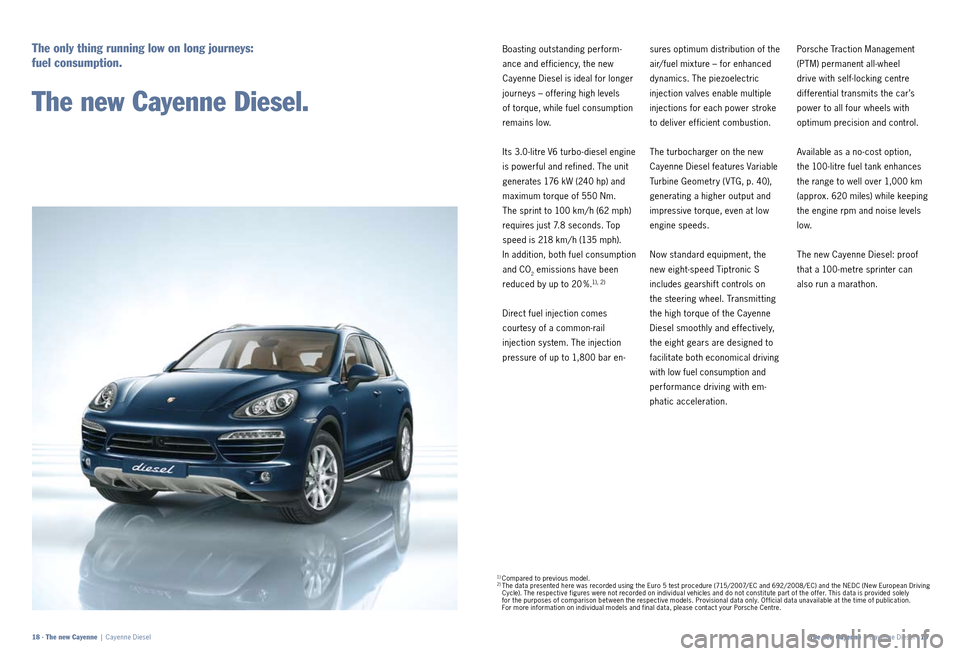
Boasting outstanding perform
ance and ef ficiency, the new
Cayenne Diesel is ideal for longer
journeys – offering high levels
of torque, while fuel consumption
remains low.
Its 3.0 litre V6 turbo diesel engine
is powerful and refined. The unit
generates 176 kW (240 hp) and
maximum torque of 550 Nm.
The sprint to 100 km/ h (62 mph)
requires just 7.8 seconds. Top
speed is 218 km/ h (135 mph).
In addition, both fuel consumption
and CO
2 emissions have been
reduced by up to 20 %.
1), 2)
Direct fuel injection comes
courtesy of a common rail
injection system. The injection
pressure of up to 1,800 bar en sures optimum distribution of the
air/fuel mixture – for enhanced
dynamics. The piezoelectric
injection valves enable multiple
injections for each power stroke
to deliver efficient combustion.
The turbocharger on the new
Cayenne Diesel features Variable
Turbine Geometry (V TG, p. 40),
generating a higher output and
impressive torque, even at low
engine speeds.
Now standard equipment, the
new eight
speed Tiptronic S
includes gearshift controls on
the steering wheel. Transmit ting
the high torque of the Cayenne
Diesel smoothly and ef fectively,
the eight gears are designed to
facilitate both economical driving
with low fuel consumption and
performance driving with em
phatic acceleration. Porsche Traction Management
(PTM) permanent all
wheel
drive with self locking centre
dif ferential transmits the car’s
power to all four wheels with
optimum precision and control.
Available as a no cost option,
the 100 litre fuel tank enhances
the range to well over 1,000 km
(approx. 620 miles) while keeping
the engine rpm and noise levels
l o w.
The new Cayenne Diesel: proof
that a 100 metre sprinter can
also run a marathon.
The only thing running low on long journeys:
fuel consumption.
The new Cayenne Diesel.
1) Compared to previous model.2) The data presented here was recorded using the Euro 5 test procedure (715/2007/ EC and 692/2008/ EC) and the NEDC (New European Driving
Cycle). The respective figures were not recorded on individual vehicles and do not constitute part of the of fer. This data is provided solely
for the purposes of comparison bet ween the respective models. Provisional data only. Of ficial data unavailable at the time of publication.
For more information on individual models and final data, please contact your Porsche Centre.
The new Cayenne | Cayenne Diesel · 19
18 · The new Cayenne | Cayenne Diesel
Page 10 of 68

Understatement coupled with
clear statements: lower fuel
consumption, faster acceleration.
Supreme engineering that speaks
for itself. In short, every thing
you’d expect from a Turbo.
Another clear statement is the
distinctive sound from the t win
dualtube tailpipes. Produced by
the 4.8 litre t win turbo V8 engine
that delivers 368 kW (500 hp)
and features direct fuel injection
(DFI, p. 38). The car has a top
speed of 278 km/ h (173 mph)
and the benchmark sprint from
0 to 100 km/ h (62 mph) is com
pleted in 4.7 seconds. Maximum
torque is 700 Nm. Here too, fuel
consumption has been reduced
by
23 % and CO2 emissions by
2 5 % .
1), 2) Not least thanks to a
weight saving of 185 kg
1).
Optimum traction and safet y are
provided by Porsche Traction
Management (PTM, p. 44) active
all wheel drive. Also connecting
the car to the road are the new
19 inch Cayenne Turbo wheels. The chassis on the new Cayenne
Turbo is equipped as standard
with air suspension
featuring self
levelling and ride height control,
as well as Porsche Active Suspen
sion Management
(PASM, p. 51).
This electronic damping control
system offers continuous adjust
ment of the damping forces
on each wheel – depending on
current road conditions and
driving st yle.
This enables greater
car control, improving safet y and
comfort.
Comfort is also key in the new
Cayenne Turbo interior. Standard
equipment comprises an interior
package in smooth finish leather,
a rooflining in Alcantara and an
electrically adjustable steering
column.
Also fit ted as standard: the
BOSE® Surround Sound System,
Porsche Communication
Management (PCM) with navi
gation module, adaptive sports
seats with comfort memor y
package (18 way), Tyre Pressure Monitoring (TPM, p. 57), auto
matic headlight activation and
automatically dimming exterior
and interior mirrors.
Exterior features exclusive to
the new Cayenne Turbo include
Bi
Xenon headlights with Porsche
Dynamic Light System (PDLS,
p. 61), larger air intakes and a
distinctive ‘power dome’ on the
engine lid – a clear reference to
the enormous potential within.
Based on the same solid
foun
dations as its predecessor,
the new Cayenne Turbo blends
phenomenal performance with
comfort and ef ficiency. It does
so in st yle but without ever
compromising on any one in
particular. Because we believe
that less can also mean more.
Reduced weight, lower fuel consumption, fewer emissions.
At Porsche, we believe less is more.
The new Cayenne Turbo.
1) Compared to previous model.2) The data presented here was recorded using the Euro 5 test procedure (715/2007/ EC and 692/2008/ EC) and the NEDC (New European Driving
Cycle). The respective figures were not recorded on individual vehicles and do not constitute part of the of fer. This data is provided solely
for the purposes of comparison bet ween the respective models. Provisional data only. Of ficial data unavailable at the time of publication.
For more information on individual models and final data, please contact your Porsche Centre.
The new Cayenne | Cayenne Turbo · 25
24 · The new Cayenne | Cayenne Turbo
Page 17 of 68
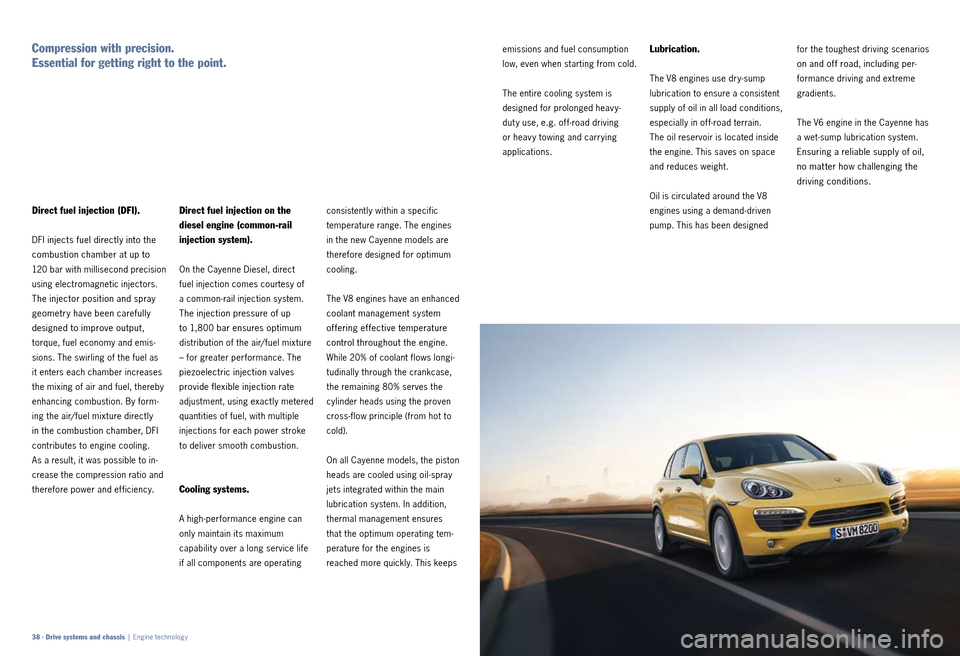
consistently within a specific
temperature range. The engines
in the new Cayenne models are
therefore designed for optimum
cooling.
The V8 engines have an enhanced
coolant management system
offering effective temperature
control throughout the engine.
While 20% of coolant flows longi
tudinally through the crankcase,
the remaining 80% serves the
cylinder heads using the proven
cross flow principle (from hot to
cold).
On all Cayenne models, the piston
heads are cooled using oil spray
jets integrated within the main
lubrication system. In addition,
thermal management ensures
that the optimum operating tem
perature for the engines is
reached more quickly. This keeps emissions and fuel consumption
low, even when starting from cold.
The entire cooling system is
designed for prolonged heav y
dut y use, e.g. of f road driving
or heav y towing and carrying
applications.
Lubrication.
The V8 engines use dry sump
lubrication to ensure a consistent
supply of oil in all load conditions,
especially in of f road terrain.
The oil reservoir is located inside
the engine. This saves on space
and reduces weight.
Oil is circulated around the V8
engines using a demand driven
pump. This has been designed for the toughest driving scenarios
on and off road, including per
formance driving and extreme
gradients.
The V6 engine in the Cayenne has
a wet sump lubrication system.
Ensuring a reliable supply of oil,
no mat ter how challenging the
driving conditions.
Direct fuel injection on the
diesel engine (common-rail
injection system).
On the Cayenne Diesel, direct
fuel injection comes courtesy of
a common rail injection system.
The injection pressure of up
to 1,800 bar ensures optimum
distribution of the air/fuel mixture
– for greater performance. The
piezoelectric injection valves
provide flexible injection rate
adjustment, using exactly metered
quantities of fuel, with multiple
injections for each power stroke
to deliver smooth combustion.
Cooling systems.
A high performance engine can
only maintain its maximum
capabilit y over a long service life
if all components are operating
Direct fuel injection (DFI).
DFI injects fuel directly into the
combustion chamber at up to
120 bar with millisecond precision
using electromagnetic injectors.
The injector position and spray
geometry have been carefully
designed to improve output,
torque, fuel economy and emis
sions. The swirling of the fuel as
it enters each chamber increases
the mixing of air and fuel, thereby
enhancing combustion. By form
ing the air/fuel mixture directly
in the combustion chamber, DFI
contributes to engine cooling.
As a result, it was possible to in
crease the compression ratio and
therefore power and efficiency.
Compression with precision.
Essential for getting right to the point.
38 · Drive systems and chassis | Engine technology
Page 18 of 68
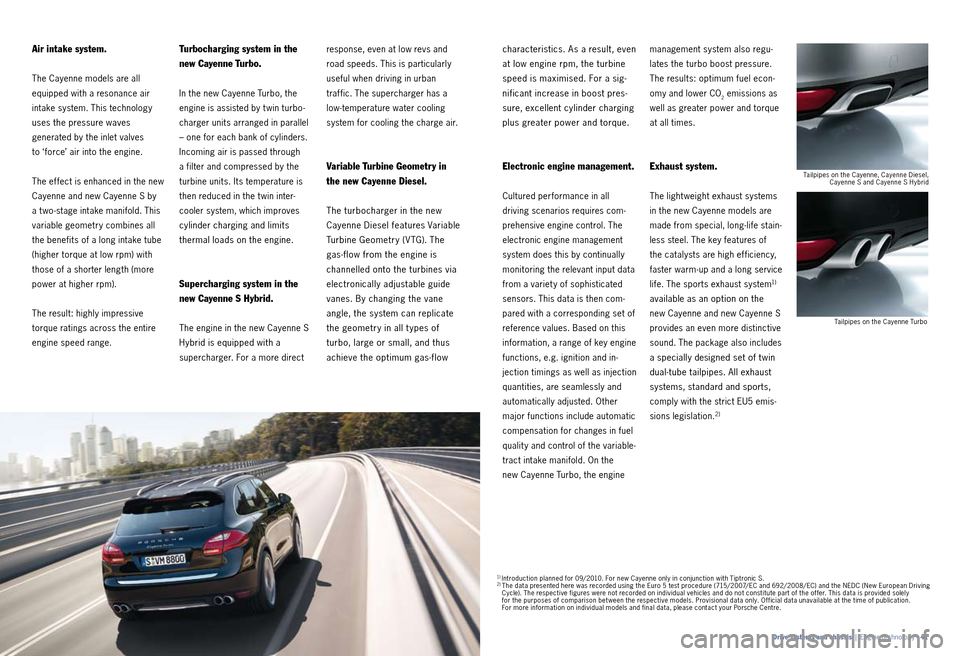
response, even at low revs and
road speeds. This is particularly
useful when driving in urban
traf fic. The supercharger has a
lowtemperature water cooling
system for cooling the charge air.
Variable Turbine Geometry in
the new Cayenne Diesel.
The turbocharger in the new
Cayenne Diesel features Variable
Turbine Geometry (V TG). The
gas flow from the engine is
channelled onto the turbines via
electronically adjustable guide
vanes. By changing the vane
angle, the system can replicate
the geometry in all t ypes of
turbo, large or small, and thus
achieve the optimum gas flow characteristics. As a result, even
at low engine rpm, the turbine
speed is maximised. For a sig
nificant increase in boost pres
sure, excellent cylinder charging
plus greater power and torque.
Electronic engine management.
Cultured performance in all
driving scenarios requires com
prehensive engine control. The
electronic engine management
system does this by continually
monitoring the relevant input data
from a variet y of sophisticated
sensors. This data is then com
pared with a corresponding set of
reference values. Based on this
information, a range of key engine
functions, e.g. ignition and in
jection timings as well as injection
quantities, are seamlessly and
automatically adjusted. Other
major functions include automatic
compensation for changes in fuel
qualit y and control of the variable
tract intake manifold. On the
new Cayenne Turbo, the engine management system also regu
lates the turbo boost pressure.
The results:
optimum fuel eco
n
omy and lower CO
2 emissions as
well as greater power and torque
at all times.
Exhaust system.
The light weight exhaust systems
in the new Cayenne models are
made from special, long life stain
less steel. The key features of
the catalysts are high ef ficiency,
faster warm up and a long service
life. The sports exhaust system
1)
available as an option on the
new Cayenne and new Cayenne S
provides an even more distinctive
sound. The package also includes
a specially designed set of t win
dual tube tailpipes. All exhaust
systems, standard and sports,
comply with the strict EU5 emis
sions legislation.
2)
Turbocharging system in the
new Cayenne Turbo.
In the new Cayenne Turbo, the
engine is assisted by t win turbo
charger units arranged in parallel
– one for each bank of cylinders.
Incoming air is passed through
a filter and compressed by the
turbine units. Its temperature is
then reduced in the t win inter
cooler system, which improves
cylinder charging and limits
thermal loads on the engine.
Supercharging system in the
new Cayenne S Hybrid.
The engine in the new Cayenne S
Hybrid is equipped with a
supercharger. For a more direct
Air intake system.
The Cayenne models are all
equipped with a resonance air
intake system. This technology
uses the pressure waves
generated by the inlet valves
to ‘force’ air into the engine.
The ef fect is enhanced in the new
Cayenne and new Cayenne S by
a t wo stage intake manifold. This
variable geometry combines all
the benefits of a long intake tube
(higher torque at low rpm) with
those of a shorter length (more
power at higher rpm).
The result: highly impressive
torque ratings across the entire
engine speed range.
1 ) Introduction planned for 09/2010. For new Cayenne only in conjunction with Tiptronic S.2) The data presented here was recorded using the Euro 5 test procedure (715/2007/ EC and 692/2008/ EC) and the NEDC (New European Driving
Cycle). The respective figures were not recorded on individual vehicles and do not constitute part of the of fer. This data is provided solely
for the purposes of comparison bet ween the respective models. Provisional data only. Of ficial data unavailable at the time of publication.
For more information on individual models and final data, please contact your Porsche Centre. Tailpipes on the Cayenne, Cayenne Diesel,
Cayenne S and Cayenne S Hybrid
Tailpipes on the Cayenne Turbo
Drive systems and chassis | Engine technology · 41
Page 26 of 68

Ty r e s .
All t yres have been optimised
with regard to driving perform
ance, handling, rolling resistance
and weight. They also provide
great potential for reducing fuel
consumption and emissions. The three basic components of
the t yre have been enhanced –
the rubber compound, tread de
sign and the architecture of the
substructure. This reduces rolling
resistance and fuel consumption.
Tyre Pressure Monitoring
(TPM).
Tyre Pressure Monitoring (TPM)
provides early warning of any
drop in pressure via the on
board
computer display. In addition, the driver can quickly
and easily check the individual
pressures in all four wheels via
the multi
purpose display in the
instrument cluster. Standard on the new Cayenne
Turbo. Optional for all other
new Cayenne models.
Wheels.
All of the wheels for the new
Cayenne models have been
specifically designed to reflect
the character of the car – and
convey it to the road.
Standard on the new Cayenne
and new Cayenne Diesel: the
new 18 inch Cayenne wheel.
Standard on the new Cayenne S
and new Cayenne S Hybrid:
the new 18 inch Cayenne S III
wheel. Standard on the new
Cayenne Turbo: the new 19 inch
Cayenne Turbo wheel.
1)
A range of other wheel options
in various sizes (up to 21 inches
in diameter) is available for all
models.
19 inch Cayenne Turbo wheel
20 inch RS Spyder Design wheel
18 inch Cayenne S III wheel 20
inch Cayenne SportDesign II wheel
18 inch Cayenne wheel 19
inch Cayenne Design II wheel2)
More than just a small cog in the system.
21 inch Cayenne SportEdition wheel3)21 inch 911 Turbo II wheel (forged)
1) For details of all wheel options, see page 118. 2) In conjunction with 275 mm t yres for the
Cayenne Turbo and 265 mm t yres for all
other models.
3) Introduction planned for 07/2010.
Drive systems and chassis | Chassis · 57
56 · Drive systems and chassis | Chassis
Page 30 of 68
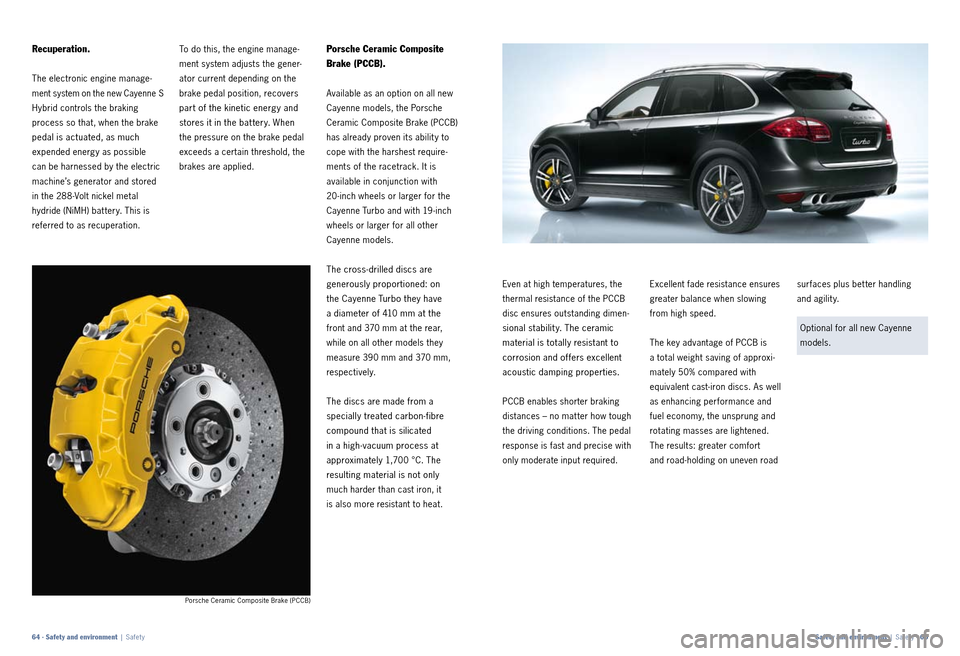
Porsche Ceramic Composite Brake (PCCB)
To do this, the engine manage
ment system adjusts the gener
ator current depending on the
brake pedal position, recovers
part of the kinetic energy and
stores it in the bat tery. When
the pressure on the brake pedal
exceeds a certain threshold, the
brakes are applied.
Porsche Ceramic Composite
Brake (PCCB).
Available as an option on all new
Cayenne models, the Porsche
Ceramic Composite Brake (PCCB)
has already proven its abilit y to
cope with the harshest require
ments of the racetrack. It is
available in conjunction with
20 inch wheels or larger for the
Cayenne Turbo and with 19 inch
wheels or larger for all other
Cayenne models.
The cross drilled discs are
generously proportioned: on
the Cayenne Turbo they have
a diameter of 410 mm at the
front and 370 mm at the rear,
while on all other models they
measure 390 mm and 370 mm,
respectively.
The discs are made from a
specially treated carbon fibre
compound that is silicated
in a high vacuum process at
approximately 1,700 °C. The
resulting material is not only
much harder than cast iron, it
is also more resistant to heat. Even at high temperatures, the
thermal resistance of the PCCB
disc ensures outstanding dimen
sional stabilit y. The ceramic
material is totally resistant to
corrosion and offers excellent
acoustic damping properties.
PCCB enables shorter braking
distances – no mat ter how tough
the driving conditions. The pedal
response is fast and precise with
only moderate input required. Excellent fade resistance ensures
greater balance when slowing
from high speed.
The key advantage of PCCB is
a total weight saving of approxi
mately 50% compared with
equivalent cast iron discs. As well
as enhancing performance and
fuel economy, the unsprung and
rotating masses are lightened.
The results: greater comfort
and road holding on uneven road surfaces plus bet ter handling
and agility.
Optional for all new Cayenne
models.
Recuperation.
The electronic engine manage
ment system on the new Cayenne S
Hybrid controls the braking
process so that, when the brake
pedal is actuated, as much
expended energy as possible
can be harnessed by the electric
machine’s generator and stored
in the 288 Volt nickel metal
hydride (NiMH) bat tery. This is
referred to as recuperation.
Safety and environment | Safet y · 65
64 · Safety and environment | Safet y
Page 37 of 68

of the car’s dynamic exterior
lines. The seat position and
three spoke steering wheel of fer
exceptional support and contact
– for an even sportier ride. A t ypical Porsche feature, yet
totally new on the Cayenne: the
five round instruments now form
the familiar cluster and are slight
ly raised from the dashboard as
a visual unit. The high resolution
4.8 inch TFT colour screen
displays information from the on
board computer or, in conjunction
with PCM including navigation
module, map data from the navi
gation system. It also shows the
set tings of the optional adaptive
cruise control or gives various
warnings, such as alerts from Tyre
Pressure Monitoring (TPM), which
is also available as an option. On the new Cayenne S Hybrid, the
display also provides information
about the energy management.
Oil pressure, oil and coolant
temperature as well as the fuel
level are displayed using analogue
gauges, while the boost pressure
gauge on the new Cayenne Turbo
is digital. A compass display in
the instrument cluster is available
as an option in conjunction with
PCM. This shows the four cardinal
and four ordinal directions with
degree increments as well as your
current altitude.
The steering column offers man
ual height and reach adjustment
(electrically adjustable on the
new Cayenne Turbo). The steering
wheel rim is in smooth
finish
leather. As is the optional three
spoke sports steering wheel with
gearshif t paddles – for genuine
race st yle gearshif t action. Also
available as an option, the three
spoke multifunction steering
wheel enables easy access to
a range of functions including
audio and telephone.
Particularly striking features in
clude the way the centre console
rises to meet the dashboard –
clearly inspired by the Carrera GT.
This immediately enhances the
interior structure, a continuation
As on every Porsche, the interior
of the new Cayenne is designed
around the driver, combining
sporting st yle with the very high
est standards of ergonomics,
comfort and qualit y.
Déjà vu, yet totally new.
Comfort.
Cayenne Turbo with walnut interior package in t wo tone combination (Umber/Cream)
Comfort and transport | Comfort · 79
78 · Comfort and transport | Comfor t
Page 57 of 68
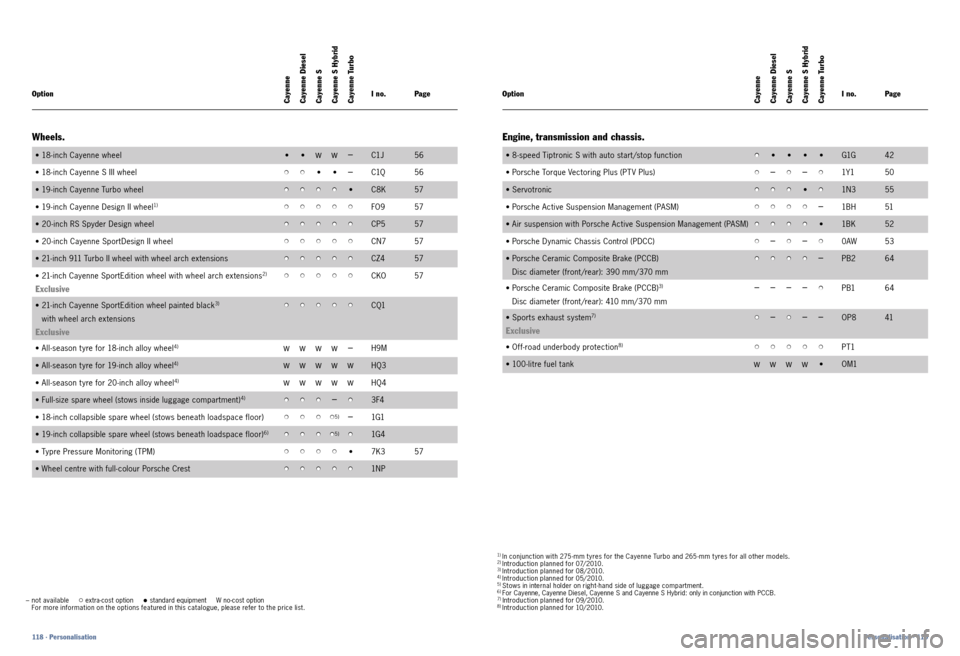
1 ) In conjunction with 275 mm t yres for the Cayenne Turbo and 265 mm t yres for all other models.2 ) Introduction planned for 07/2010.3) Introduction planned for 08/2010.4 ) Introduction planned for 05/2010.5 ) Stows in internal holder on right hand side of luggage compartment.6 ) For Cayenne, Cayenne Diesel, Cayenne S and Cayenne S Hybrid: only in conjunction with PCCB.7 ) Introduction planned for 09/2010.8 ) Introduction planned for 10/2010.
Personalisation · 119
118 · Personalisation
– not available extracost option• standard equipment W nocost option
For more information on the options featured in this catalogue, please refer to the price list.
Wheels.
• 18-inch Cayenne wheel • •w w–C1J
56
• 18-inch Cayenne S III wheel
••• •–C1Q 56
• 19 -inch Cayenne Turbo wheel
••••• C8K 57
• 19-inch Cayenne Design II wheel
1)•••••FO9 57
• 20 - inch RS Spyder Design wheel
•••••CP5 57
• 20 -inch Cayenne SportDesign II wheel
•••••CN7 57
• 21- inch 911 Turbo II wheel with wheel arch extensions
•••••CZ4 57
• 21-inch Cayenne SportEdition wheel with wheel arch extensions
2)
Exclusive
•••••CKO 57
•
21-inch Cayenne SportEdition wheel painted black
3)
with wheel arch extensions
Exclusive
•••••CQ1
• All-season t yre for 18-inch alloy wheel
4)w w w w –H9M
•
All-season t yre for 19 -inch alloy wheel
4)w w w w wHQ3
• All-season t yre for 20 -inch alloy wheel
4)w w w w wHQ4
• Full-size spare wheel (stows inside luggage compartment)
4)••• –•3 F4
•
18 - inch collapsible spare wheel (stows beneath loadspace floor)
••••5)–1G1
• 19 -inch collapsible spare wheel (stows beneath loadspace floor)
6) ••••5)•1G 4
• Typre Pressure Monitoring (TPM)
••••• 7K3 57
• Wheel centre with full - colour Porsche Crest
•••••1N P
Cayenne
Cayenne Diesel
Cayenne S
Cayenne S Hybrid
Cayenne TurboI no. Page
Option
Engine, transmission and chassis.
• 8 -speed Tiptronic S with auto start /stop function •• • • • G1G42
• Porsche Torque Vectoring Plus (PT V Plus)
• –•–•1Y 1
50
• Servotronic
•••••1N3 55
• Porsche Active Suspension Management (PASM)
•••• –1B H
51
•
Air suspension with Porsche Active Suspension Management (PASM)
••••• 1B K 52
• Porsche Dynamic Chassis Control (PDCC)
• –•–•0AW
53
•
Porsche Ceramic Composite Brake (PCCB)
Disc diameter (front/rear): 390 mm/370 mm
•••• –PB2
64
•
Porsche Ceramic Composite Brake (PCCB)
3)
Disc diameter (front/rear): 410 mm/370 mm– – – –•PB1 64
• Sports exhaust system
7)
Exclusive
• –•– –OP8
41
• Off-road underbody protection
8) •••••PT1
• 100 - litre fuel tank
w w w w• OM1
Cayenne
Cayenne Diesel
Cayenne S
Cayenne S Hybrid
Cayenne TurboI no. Page
Option
Page 66 of 68
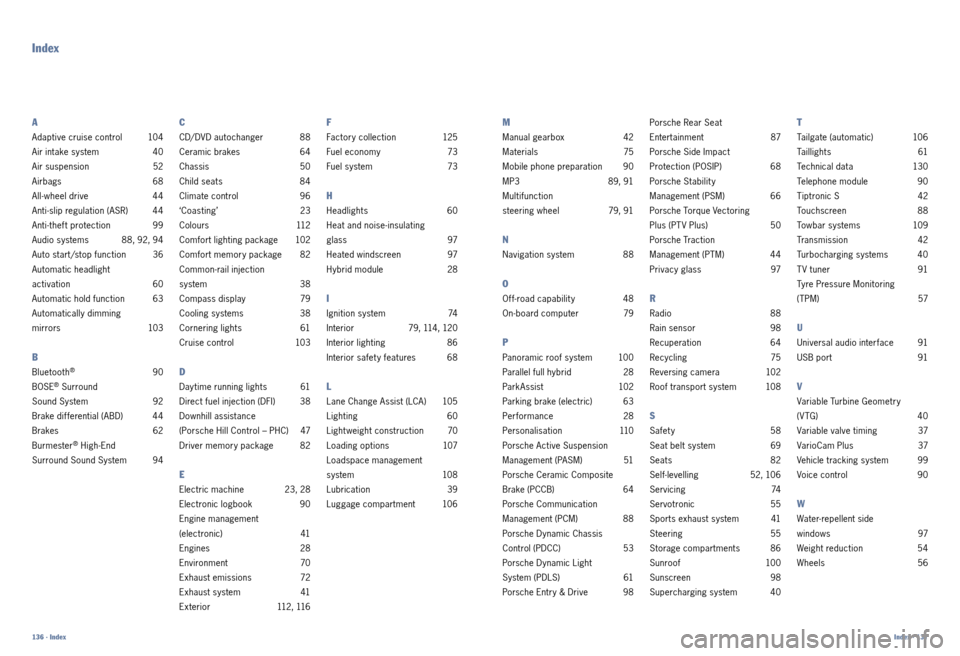
Index
A
Adaptive cruise control 104
Air intake system 40
Air suspension 52
Airbags 68
All wheel drive 44
Anti slip regulation (ASR) 44
Anti theft protection 99
Audio systems 88, 92, 94
Auto start /stop function 36
Automatic headlight
activation 60
Automatic hold function 63
Automatically dimming
mirrors 103
B
Bluetooth® 90
BOSE
® Surround
Sound System 92
Brake differential (ABD) 44
Brakes 62
Burmester
® High End
Surround Sound System 94
C
CD/ DVD autochanger 88
Ceramic brakes 64
Chassis 50
Child seats 84
Climate control 96
‘Coasting’ 23
C o l o u r s 112
Comfort lighting package 102
Comfort memory package 82
Common rail injection
system 38
Compass display 79
Cooling systems 38
Cornering lights 61
Cruise control 103
D
Day time running lights 61
Direct fuel injection (DFI) 38
Downhill assistance
(Porsche Hill Control – PHC) 47
Driver memory package 82
E
Electric machine 23, 28
Electronic logbook 90
Engine management
(electronic) 41
Engines 28
Environment 70
Exhaust emissions 72
Exhaust system 41
E x t e r i o r 112 , 116
F
Factory collection 125
Fuel economy 73
Fuel system 73
H
Headlights 60
Heat and noise insulating
glass 97
Heated windscreen 97
Hybrid module 28
I
Ignition system 74
Interior 79, 114, 120
Interior lighting 86
Interior safet y features 68
L
Lane Change Assist (LCA) 105
Lighting 60
Lightweight construction 70
Loading options 107
Loadspace management
system 108
Lubrication 39
Luggage compartment 106
M
Manual gearbox 42
Materials 75
Mobile phone preparation 90
MP3 89, 91
Multifunction
steering wheel 79, 91
N
Navigation system 88
O
Offroad capabilit y 48
On board computer 79
P
Panoramic roof system 100
Parallel full hybrid 28
Park Assist 102
Parking brake (electric) 63
Performance 28
Personalisation 110
Porsche Active Suspension
Management (PASM) 51
Porsche Ceramic Composite
Brake (PCCB) 64
Porsche Communication
Management (PCM) 88
Porsche Dynamic Chassis
Control (PDCC) 53
Porsche Dynamic Light
System (PDLS) 61
Porsche Entry & Drive 98Porsche Rear Seat
Entertainment 87
Porsche Side Impact
Protection (POSIP) 68
Porsche Stabilit y
Management (PSM) 66
Porsche Torque Vectoring
Plus (PT V Plus) 50
Porsche Traction
Management (PTM) 44
Privacy glass 97
R
Radio 88
Rain sensor 98
Recuperation 64
Recycling 75
Reversing camera
1
02
Roof transport system 108
S
Safety 58
Seat belt system 69
Seats 82
Self levelling 52, 106
S e rv i c i n g 74
Servotronic 55
Sports exhaust system 41
Steering 55
Storage compartments 86
S u n r o o f 10 0
Sunscreen 98
Supercharging system 40
T
Tailgate (automatic) 106
Taillights 61
Technical data 130
Telephone module 90
Tiptronic S 42
Touchscreen 88
Towbar systems 109
Tra n s m i s si o n 42
Turbocharging systems 40
T V tuner 91
Tyre Pressure Monitoring
( T PM) 57
U
Universal audio interface 91
USB port 91
V
Variable Turbine Geometry
(V TG) 40
Variable valve timing 37
VarioCam Plus 37
Vehicle tracking system 99
Voice control 90
W
Waterrepellent side
windows 97
Weight reduction 54
Wheels 56
Index · 137
136 · Index